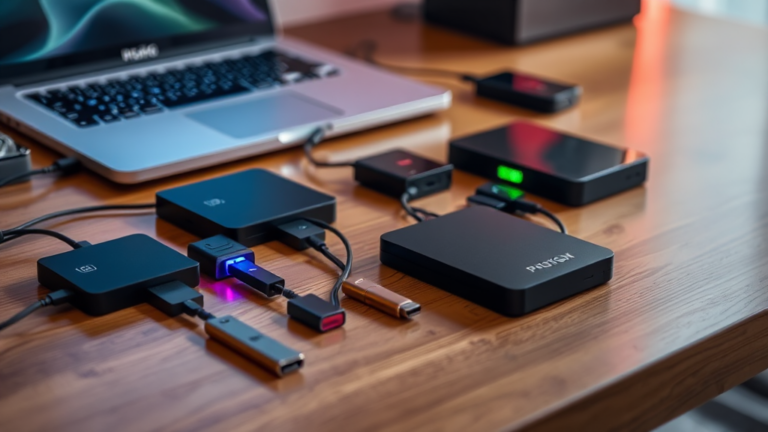Traveling with your digital devices poses unique challenges for data security. This guide explores cloud storage and physical backups, offering practical tips to keep your information safe on the go.
Understanding Cloud Storage for Travelers
Cloud storage offers a convenient way to access your files from anywhere. Popular options include:
- Google Drive
- Dropbox
- iCloud
- OneDrive
Benefits of cloud storage for travelers:
- Access files from any device with internet connection
- Automatic syncing across devices
- No need to carry physical storage devices
However, cloud storage requires a stable internet connection, which may not always be available during travel.
Physical Backups: A Reliable Alternative
Physical backups provide a tangible way to store your data. Options include:
- External hard drives
- USB flash drives
- Portable SSDs
Advantages of physical backups:
- Access your data without internet
- Complete control over your files
- One-time investment with no recurring fees
Remember to keep physical backups secure and separate from your primary device to prevent loss or theft.
Comparing Cloud Storage and Physical Backups
| Feature | Cloud Storage | Physical Backups |
|---|---|---|
| Accessibility | Anywhere with internet | Physical access required |
| Capacity | Scalable, often with fees | Fixed, one-time purchase |
| Security | Encryption, but potential for hacks | Physical security needed |
| Sync | Automatic across devices | Manual updates required |
Consider using both methods for maximum data protection while traveling.
Best Practices for Data Backup on the Go
Follow these tips to ensure your data stays safe during your travels:
- Encrypt your backups for an extra layer of security
- Use strong, unique passwords for all your accounts and devices
- Enable two-factor authentication whenever possible
- Update your backups regularly, especially before and after trips
- Keep physical backups in a secure, separate location from your main device
- Use a VPN when connecting to public Wi-Fi networks
By implementing these practices, you can significantly reduce the risk of data loss or theft while traveling.
Choosing the Right Backup Method
Selecting the optimal backup strategy depends on your specific travel needs. Consider these factors:
- Duration of your trip
- Internet availability at your destination
- Amount of data you need to back up
- Budget for storage solutions
For short trips with reliable internet, cloud storage might suffice. Longer journeys or data-intensive work may require a combination of cloud and physical backups.
Cloud Storage Recommendations
Popular cloud storage options for travelers:
- Google Drive: 15GB free storage, seamless integration with Google apps
- Dropbox: 2GB free storage, user-friendly interface
- iCloud: 5GB free storage, ideal for Apple users
- pCloud: Lifetime plans available, strong encryption options
Physical Backup Options
Reliable physical storage devices for travel:
- Samsung T7 Portable SSD: Fast, compact, and durable
- SanDisk Extreme Portable SSD: Rugged design, water-resistant
- WD My Passport Ultra: Large capacity options, automatic backup software
Implementing a Multi-Layered Backup Strategy
A robust backup plan combines multiple methods to ensure data safety:
- Daily cloud sync: Set up automatic syncing for essential files
- Weekly physical backups: Perform a full backup to an external drive
- Offline copies: Keep critical documents on an encrypted USB drive
This approach provides redundancy and access to your data in various scenarios.
Securing Your Devices While Traveling
Protect your devices and data with these security measures:
- Use a VPN: Encrypt your internet connection on public Wi-Fi
- Enable device encryption: Protect data if your device is lost or stolen
- Install antivirus software: Guard against malware and cyber threats
- Use a privacy screen: Prevent visual hacking in public spaces
Regularly update your devices and software to patch security vulnerabilities.
Handling Sensitive Data on the Road
Take extra precautions with sensitive information:
- Use a password manager: Generate and store complex passwords securely
- Implement file-level encryption: Protect individual sensitive documents
- Avoid accessing sensitive accounts on public computers or networks
- Enable remote wipe features on your devices
Consider leaving highly sensitive data at home if it’s not essential for your trip.
Conclusion
Effective data protection while traveling requires a combination of smart backup strategies and security practices. By implementing cloud storage, physical backups, and robust security measures, you can safeguard your digital information on the go.
Remember to:
- Choose the right backup methods for your travel needs
- Use a multi-layered backup approach
- Secure your devices with encryption and VPNs
- Handle sensitive data with extra care
With these strategies in place, you can travel with confidence, knowing your data is safe and accessible when you need it.










